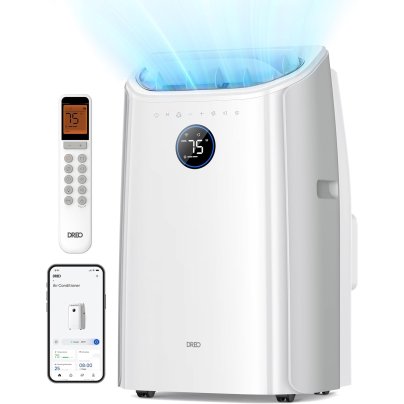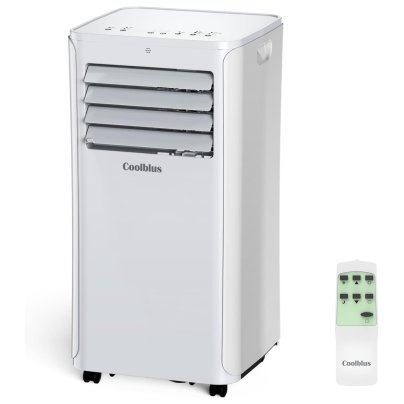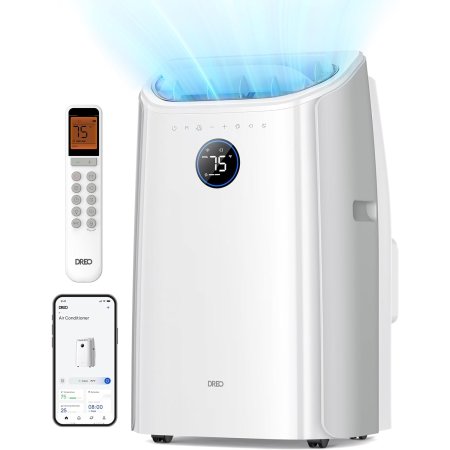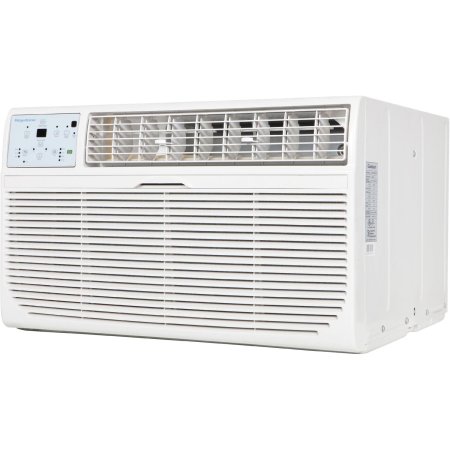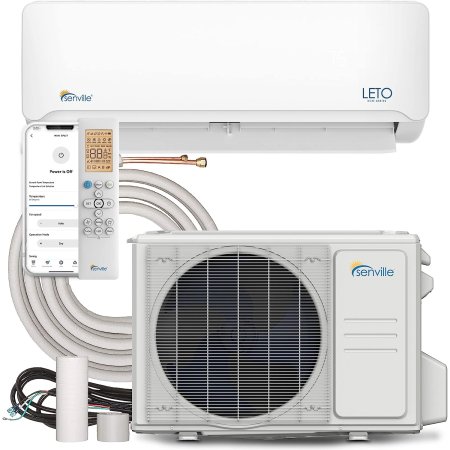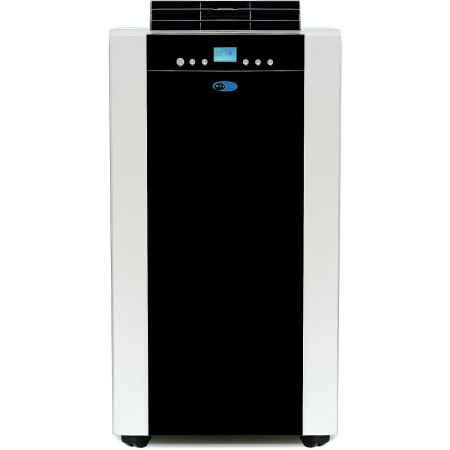
We may earn revenue from the products available on this page and participate in affiliate programs. Learn More ›
Garage air conditioners turn sweltering workshops into cool, comfortable spaces. Working in a garage or outbuilding that’s not temperature-controlled in some regions can be virtually impossible in the summertime because the space gets too hot. We’re big fans of being able to work in our shops all year round, so we researched more than 30 units and then tested four models in different categories. Based on our extensive research, we also included additional models that we didn’t get our hands on, but we think may be worth a look.
While all the air conditioners we tested did a good job keeping our garage cool, we found a favorite. The Dreo 12,000 BTU Smart Air Conditioner earned the top spot in our lineup thanks to its ability to quickly cool and dehumidify spaces up to 350 square feet—and do it quietly.
Keep reading to discover some of the nifty features today’s AC manufacturers are incorporating into their units. Plus, find out how the following models performed in our hands-on tests and earned a spot in this lineup of the best garage air conditioners.
- BEST OVERALL: Dreo 12,000 BTU Smart Air Conditioner
↓ Jump to Review - BEST BANG FOR THE BUCK: Coolblus 12,000 BTU Portable Air Conditioner
↓ Jump to Review - BEST WINDOW-MOUNT: LG Dual Inverter Smart Window Air Conditioner
↓ Jump to Review - BEST DIY INSTALLATION: Keystone 14,000 BTU Through-the-Wall Air Conditioner
↓ Jump to Review - BEST EFFICIENCY: Senville Mini Split Air Conditioner Heat Pump
↓ Jump to Review - BEST PORTABLE POWER: Whynter 14,000 BTU Dual-Hose Portable Air Conditioner
↓ Jump to Review
Before You Buy a Garage Air Conditioner
While an air conditioner will reduce the temperature in a toasty garage, the results will vary from garage to garage due to the amount of insulation in the walls and ceiling, the humidity level, and the outdoor temperature.
For the best (and most energy-efficient) results, take simple steps to keep the cooled air in and reduce energy loss before installing a garage air conditioner. Look for holes in the structure where cold air will escape and seal them. Consider adding an overhead fan to circulate the air, and your garage will be easier to cool.
| Testing Stats | |
| Products tested | 4 |
| Time spent testing | 10 hours |
| Tests performed | 3 |
| Price range | $200 to $600 |
Our Top Picks
Whether you have a small workshop or a multicar garage, one of the following AC units can make it a more comfortable place for working on your projects. Here, you’ll find our four top tested models, plus a couple of ACs we didn’t test but are recommending based on quality, efficiency, and consumer enthusiasm.
Best Overall
Dreo 12,000 BTU Smart Air Conditioner
What We Like
- Efficiently cools up to 35 square feet
- Enhanced dehumidifying feature
- Just 46 decibels (dB) of noise on lowest speed
- Syncs with smartphone for advanced control
What We Don’t Like
- Garages larger than 350 square feet might need a larger unit
Product Specs
- Type: Portable
- British thermal units (BTUs): 12,000
- Voltage: 115
Our Ratings: Installation 5/5; Performance 4.8/5; Noise 4.5/5; Maintenance 4.5/5; Value 4.75/5
Dreo did it again! This is one very cool portable garage AC unit. In our tests, the Dreo AC515S reduced the indoor temperature of our garage from 80 to 70 degrees Fahrenheit in just 45 minutes. We thought that was pretty good considering it was 98 degrees Fahrenheit outside. Plus, our garage isn’t insulated, so the Dreo had its work cut out for it.
This is a one-hose model, which means it has an exhaust hose designed to fit a double-hung or slider window but no intake hose. We prefer this design because it’s cleaner looking than having two hoses running out a window. The air intake on the Dreo is on the unit’s backside—it draws in air from the garage space.
This is a quiet, single-room air conditioner, and the hum that it emits is akin to white noise—it’s more comforting than annoying. It features smooth-rolling caster wheels that allowed us to move it with ease, but our favorite feature was the smart connectivity that let us sync the unit to our wireless network and control it remotely from our smartphone. It also has a separate remote control for those who aren’t techie geeks like us.
Get the Dreo garage air conditioner at Amazon, The Home Depot, or Walmart.
Best Bang For The Buck
Coolblus 12,000 BTU Portable Air Conditioner
What We Like
- Affordable option for cooling your workshop
- Reduced temperature from 80 to 70 degrees Fahrenheit in 55 minutes
- Ideal for 1-car garages
- Remote control for convenient operation
What We Don’t Like
- Not as quiet as other tested models, but not extremely loud
- Cooling results will depend on insulation and outdoor temps
Product Specs
- Type: Portable
- BTUs: 12,000
- Voltage: 115
Our Ratings: Installation 5/5; Performance 4.3/5; Noise 4.5/5; Maintenance 4/5; Value 4.5/5
You don’t have to spend a lot to get some cool relief in your workshop. The Coolblus 12,000 BTU portable air conditioner is just the ticket for an affordable AC unit for garage use. This model doesn’t have a lot of bells and whistles, but it reduced the temperature in our garage from 80 to 70 degrees Fahrenheit in 55 minutes. That’s 10 minutes longer than it took the Dreo to reduce the temperature, but once it reached 70 degrees Fahrenheit, we slowed the fan speed, and it did a good job of maintaining the temperature for the next 1.5 hours.
Although Coolblus says it will keep spaces up to 550 square feet cool—approximately the size of many 2-car garages—we feel it’s better suited to a 1-car garage or up to about 350 square feet. Of course, it all depends on the structure’s insulation level and the outdoor temperature.
This is a one-hose unit with a nice window kit for exhausting the warm air, a byproduct of the condensing process. It has an LED control panel with easy-to-see buttons and room temperature. We could choose High or Low speeds or Sleep mode, which was quieter but not as quiet as the Dreo. It also comes with a remote control. This is a great little portable AC unit for garage or workshop use.
Get the Coolblus garage air conditioner at Amazon.
Best Window-Mount
LG Dual Inverter Smart Window Air Conditioner
What We Like
- Easy to install and remove from standard windows
- Smart hands-free operations
- Energy-efficient operation
- Multiple cooling modes
What We Don’t Like
- Requires a compatible window, which some garages do not have
- Blocks some natural light coming through the window
Product Specs
- Type: Window AC
- BTUs: 14,000
- Voltage: 115
Our Ratings: Installation 4.5/5; Performance 4.8/5; Noise 4.5/5; Maintenance 4.5/5; Value 5/5
Window units are easy to set up for summer and remove when the hot season subsides. This LG model can cool 1- to 3-car garages or up to 800 square feet. We tested this in a 240-square-foot garage and found it to be a powerful AC. It reduced the temperature from 80 to 70 degrees Fahrenheit in just over 20 minutes on High.
It was moderately loud at the highest speed but impressively quiet at the lowest speed, generating just 44 decibels of noise. This 14,000 BTU model has a combined energy efficiency ratio (CEER) of 14.7 and qualifies for Energy Star certification.
It has four different fan speeds and is also a smart model. We downloaded the app and followed the prompts to sync the appliance. A handy mobile app also acts as a convenient remote control. We didn’t have a window in our garage, so we framed a wall in the pass-through doorway to test the LG air conditioner. However, it fits standard windows with 27- to 39-inch widths and 16-inch heights.
This is an excellent garage AC kit for anyone who has a suitably sized window in their garage or is willing to frame it into a wall. It would also make a very nice indoor AC unit for a home.
Get the LG 14,000-BTU garage air conditioner at Abt.
Best DIY Installation
Keystone 14,000 BTU Through-the-Wall Air Conditioner
What We Like
- Filter is accessible from front panel for easy cleaning
- Multiple fan speeds help control circulation
- Removes moisture during the cooling process
- Remote control and Wi-Fi capability
What We Don’t Like
- Wall sleeve for installation must be purchased separately
- Air conditioner only; this unit does not have heating abilities
- Requires 230 volts and will not plug directly into a wall outlet
Product Specs
- Type: Through-the-wall
- BTUs: 14,000
- Voltage: 230 (20 Amp)
Our Ratings: Installation 4.5/5; Performance 4.8/5; Noise 4/5; Maintenance 4/5; Value 4.3/5
This through-the-wall model will easily cool most 2-car or 3-car garages. The Keystone air conditioner is designed to be installed within a garage wall. It’s best suited for someone who is replacing an existing through-the-wall unit where the exterior sleeve is already in place. You’ll want to purchase a sleeve separately if it’s a new install.
This 14,000 BTU AC is a powerful unit. It reduced the garage temperature from 80 to 70 degrees Fahrenheit in just 20 minutes. We liked the speed and power of Keystone’s cooling, but we weren’t fans of the control panel. Rather than words, the panel features only symbols, and while some are immediately recognizable—a crescent moon signifies Sleep mode—others aren’t. Eventually, you will likely learn all the modes behind the symbols, but we wished Keystone included some words.
One thing of note here: This Keystone air conditioner for garages requires a 230-volt 20-amp outlet. We didn’t have one in our garage, but we were able to test it by plugging it into a gas-powered generator that had a 20-amp outlet. Many garages don’t have 20-amp outlets; if yours doesn’t, you’ll likely need an electrician to install a dedicated 20-amp circuit.
Get the Keystone garage air conditioner at Amazon.
More Great Options
We didn’t test the following two models, but based on our in-depth research we think both would be well suited for cooling a garage or workshop.
Best Efficiency
Senville Mini Split Air Conditioner Heat Pump
What We Like
- Compatible with Alexa for voice-command controls
- Also has a heat pump for warming in winter
- Uses a DC inverter for reduced energy consumption
What We Don’t Like
- Professional installation is probably necessary
- More expensive than window or portable units
Product Specs
- Type: Mini split
- BTUs: 24,000
- Voltage: 220
Those looking for a garage air conditioner that can quickly cool just about any space will appreciate this powerful mini-split. It sits neatly on a high wall while pumping cool air into the garage. At 24,000 BTUs, it’s the most powerful option on our list.
As a mini-split, this unit takes up minimal interior space; the bulk of the unit sits outside. One thing we really like is the near-silent operation inside the workshop. If you’re a craftsperson or artist who values peace and quiet, you’ll like the fact that the Senville generates just 35 decibels at its lowest speed. That’s comparable to the sound of rustling leaves. We could totally live with that.
It comes with an installation kit for DIYers, but we suggest using a professional service because mini-split installation can be tricky, and it will need a 20-amp outlet. With hands-free operating options and powerful output, it’s an excellent choice for cooling a garage that doubles as a workspace or gym. This unit is made to work hard and handle the rigorous cooling needs of even a large garage. It has a seasonal energy efficiency ratio (SEER) of 18 and syncs with Alexa for voice-control commands.
Get the Senville garage air conditioner at Amazon or Walmart.
Best Portable Power
Whynter 14,000 BTU Dual-Hose Portable Air Conditioner
What We Like
- Thermostat for set-it-and-forget-it control
- Powerful cooling abilities, plus fan and dehumidifying modes
- Has a digital panel, remote control, and 24-hour timer
What We Don’t Like
- Could be more efficient to reduce energy usage
- Reasonably quiet but noisier than some air conditioner models
Product Specs
- Type: Portable
- BTUs: 14,000
- Voltage: 115
The Whynter portable air conditioner is 2,000 BTUs more powerful than the two portable units we tested, and it has an added feature: a carbon filter that removes odors from the air as it cools. If you regularly work with solutions that produce volatile organic compounds (VOCs), this is a nice perk. We think this would do well for someone who has a paint booth or finishes wood in their shop.
The portability factor means you might set up cooling near a workbench one day and move it to the other side of your garage (or into the house) to work on organizing storage the next. All that’s needed is a window or opening to insert the adjustable vent plate.
This model has been around since 2000 and is proven in terms of reliability and performance. While it’s not the most efficient on our list, the design is intuitive and has excellent cooling power for a portable air conditioner. Garages that fit one or two cars will benefit most from its 14,000 BTU cooling capabilities.
The Whynter ARC-14S is available with air conditioning only or a heat/AC combo option. Buyers can choose according to their indoor climate and needs throughout the year. It’s reasonably quiet (56 dB) when cooling, and you can easily set a thermostat to control the coolness level.
Get the Whynter garage air conditioner at Amazon, The Home Depot, or Best Buy.
Jump to Our Top Picks
How We Chose and Tested the Best Garage Air Conditioners
Plenty of brands, sizes, and types of air conditioners are on the market, but not all are well suited to garage cooling. We considered the needs for different garage sizes as well as the function of the space. A garage can function for storage or as a shop, home gym, living space, or any other common purpose.
When considering products, we looked at different types of air conditioners and their cooling ability based on their BTU output. We also looked at each product’s energy efficiency, user feedback, and overall design.
After selecting four of today’s top AC units, we tested them in a single-car garage with 240 square feet of space. We assembled or installed each unit and then tested each one separately to see how long they took to reduce the temperature in the garage from 80 to 70 degrees Fahrenheit.
In addition to the timed temperature test, we also tried out any accessories that came with the model, such as remote controls or smart options, and we noted how loud each one was when it was running. We also stood in the corners of the space to see how well the cool air was dispersed throughout the entire garage stall.
After testing, we rated each model in several categories to determine our best overall pick and categorize the other models for their best use.
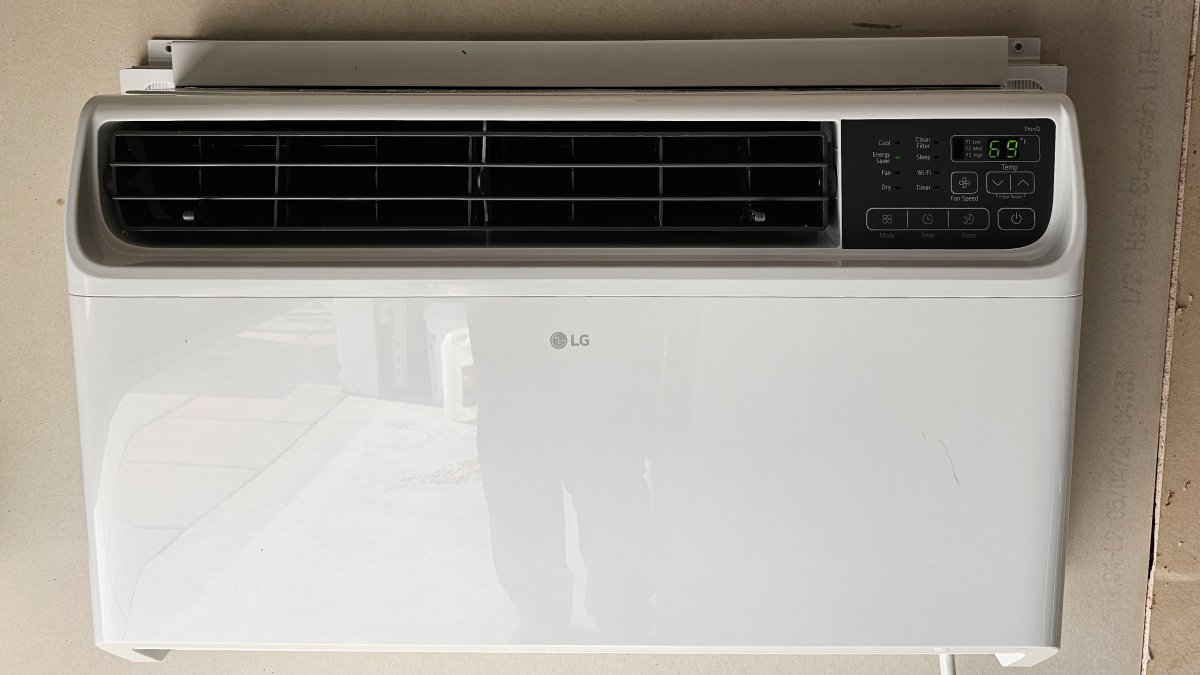
What to Consider When Choosing a Garage Air Conditioner
Before buying a garage air conditioner, review the installation requirements, power needs, energy efficiency, and overall BTU output. Some models, like the more involved mini-splits, require a hardwired electrical connection, while others need only a standard outlet. Some common models plug in, but only to 220-volt (20-amp) outlets. Regardless, the energy draw is significant on most air conditioners, and you’ll want to review available energy ratings to ensure the unit does not overload an electrical circuit. Otherwise, look for the right size and focus on energy efficiency to minimize operating costs.
Types of Garage Air Conditioners
The type of air conditioner you choose makes a big difference in efficient cooling. Portable units are great options for those who want to cool a small area within the garage, like a workspace. As a byproduct of cooling, air conditioners naturally function as dehumidifiers. Still, some units come with enhanced dehumidifying capabilities that add another layer of comfort to garages and workshops in humid climates.
Mini-Split
Often referred to as ductless heating and cooling systems, an appropriately sized mini-split is a great system for garages. It functions as a heating and cooling system that uses a heat pump to remove hot air and replace it with air that runs across a compressor and cooling tubes before entering the garage. Installation is somewhat more involved and often calls for a professional to set up the unit. Mini-splits as opposed to window air conditioners are permanently installed.
Through-the-Wall
Some garages lack standard windows. In this case, a through-the-wall air conditioner functions in the same manner but vents through a drilled hole in the garage wall. The unit pulls hot air from the garage, removes humidity, cools the air, and recirculates cold air into the room. Installation is surprisingly easy unless a garage has a thick concrete or cinder-block wall where drilling isn’t feasible. The permanent mounting style leaves windows free and doesn’t require removal after the hot season.
Window
Garage window units are an excellent option, especially for seasonal use. Installing requires a compatible garage window and removal of screens or making slight modifications to get the right fit. Window units are designed to sit on the window base while fitting flush to seal off the outside elements. They come in a large variety of BTU options to suit different garage sizes. Window units have long been a reliable cooling option that are removable when not in use. They are cost-effective and widely available.
Portable
Portability allows you to use an air conditioner only when needed (and wherever needed). You can pack it away quickly or easily move it to different areas in the garage. Some portable air conditioners still require a window or opening for air ducts to reach the exterior. A few rare units run entirely independent of outside ventilation as well.
Size
Physical size is an essential consideration for garages. An oversize air conditioner requires space. Window units block light from entering, and portable units take up floor space. Through-the-wall units can be mounted in a permanent location that is convenient for wall space uses or needs. Mini-split units are ideal because they mount high on the wall and occupy very little interior space.
Think through the space available and where the cooling is needed most within the garage. The coldest areas will be those nearest to the air conditioner. Garage fans can help distribute that air across the entire floor, however.
Energy Efficiency
Efficiency is relative to output. A higher number of BTUs increases energy consumption but also will cool a relatively large space. For example, a 10,000 BTU unit is sufficient for garages under 400 square feet (or one to two cars). A garage with 800 to 1,200 square feet will require a unit with higher BTUs (20,000+), and thus use more home energy.
The Energy Efficiency Ratio (EER) is a measure of the cooling capacity per watt of energy used. An EER of 9 is above average, and an EER of 12 is considered excellent. The higher the rating, the more efficient, which means lower electricity use and emissions. SEER is a seasonal ratio that calculates average energy over a cooling season, and most rate as 13 to 21.
The CEER is a newer, similar rating system that also takes into account standby power consumption. A CEER rating of 10 or above is considered good. In addition, if the unit is Energy Star certified by the Environmental Protection Agency, you can expect a high level of efficiency.
Efficiency is important as an environmental consideration, and it influences a home’s power bill. The cost savings in terms of energy consumption often justify spending more on an efficient unit when weighed against the long-term cost savings on power and environmental impact.

Additional Features
While size and efficiency are important, garage users will want added features to help control and enjoy the air conditioning unit. A quality remote control makes it easy to adjust temperature settings quickly. Remote controls are especially nice for units mounted high on the wall.
Eco settings and noise reduction also factor into desired features. A garage doesn’t always need the full power an air conditioner offers, and it’s nice to cycle on lower settings while conserving energy at times. Quiet units minimize disturbance in garages, which typically have concrete floors and little natural sound reduction. A decibel rating might be an important factor to check.
Lastly, units that double as garage heaters are an excellent investment for year-round use. For property owners living in environments where temperatures are cold and hot, the double use maximizes the value of the investment.
The Advantages of Using a Garage Air Conditioner
Garages can become so hot during summer and so cold in winter that the space is uninhabitable. While it can still serve as a storage space, the temperature swings can be extreme. By adding a cooling system, you can spend more time using any size of garage space.
- Cool large spaces with a single AC unit.
- Make the garage or workshop space temperate and comfortable.
- Energy-efficient options are available for garage users.
- Some air conditioning units double as heaters for use in cold temperatures.
FAQs
Venting out hot air can help you reach a cool temperature. Open windows and vents at night and cover or close them off in the morning to trap cooler air. Turn on an air conditioner to cool the space more quickly as it warms.
The best garage air conditioning practice depends on the specific situation. A mini-split is the best overall option, but you can effectively cool the space with a window unit, portable air conditioning, or through-the-wall unit.
You can install any type of AC in your garage. A mini-split is a permanent solution, but you’ll probably need to hire an AC company to install it, while other types such as a portable or small air conditioner can be temporary or seasonal solutions.
Opt for a through-the-wall model that fits in a sleeve built into the garage wall, or use a portable stand-up air conditioner and run the exhaust vent hose through an opening in the garage wall or door.
Meet the Tester
Glenda Taylor is a product tester and writer specializing in the construction, remodeling, and real estate industries. She tests a wide range of power tools as well as other home improvement, household, and lawn-and-garden products.
Additional research provided by Zach Lazzari.
